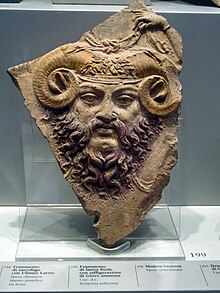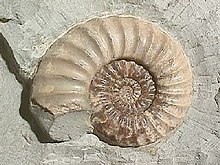Horns of Ammon

The horns of Ammon were curling ram horns, used as a symbol of the
Classical iconography


Ammon, eventually
Ammon was often depicted with ram's horns, so that as this deity became a symbol of supremacy, kings and emperors came to be depicted with Horns of Ammon on the sides of their head in profile, as well as the deities not only of Egypt, but other areas, so that Jupiter was sometimes depicted as "Jupiter Ammon", replete with Horns of Ammon, after Rome conquered Egypt, as was the Greek supreme deity
Pliny the Elder was among the earliest writers known to have associated spiral shells with the deity Ammon, referring to them as ammonis cornua (horns of Ammon) in his book Naturalis Historia.[8] Considering the relative rarity of ammonite fossils in Egypt, this may have originated with fossil snail shells like natica hybrida found in Mokattam limestone near Cairo.[1]
The direct attribution of the Horns of Ammon with fossil cephalopod shells became common during
References
- ^ a b The Origin Of Geological Terms: Ammonites
- ^ World History Encyclopedia: Yahweh
- ^ The horns of Ammon; "The biblical narrative, however, is not as straightforward as it may seem as it also includes reference to the Canaanite god El whose name is directly referenced in 'Israel' (He Who Struggles with God or He Who Perseveres with God). El was the chief deity of the Canaanite pantheon and the god who, according to the Bible, gave Yahweh authority over the Israelites."
- ^ Recent Ancient Coin Acquisitions Focus on Alexander the Great
- ^ Ammonite to Ammolite
- ISBN 978-0-19-006754-0.
- S2CID 251486595.
- ^ NH 37.40.167
